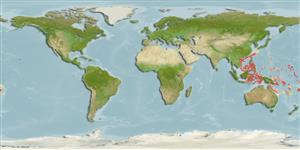>
Mulliformes (Goatfishes) >
Mullidae (Goatfishes)
Etymology: Upeneus: Greek, ypene, -es = upper lip (Ref. 45335); stenopsis: Name from the Greek word stenos, meaning 'narrow'; referring to the rather narrow (both in depth and width) caudal peduncle of the new species.
Issue
FishBase common name changed from Narrow-tail goatfish to Narrowtail goatfish (Uiblein et al., 2024: Ref. 130857).
Environment: milieu / climate zone / depth range / distribution range
Οικολογία
Θαλασσινό(ά) βενθικό(ς); εύρος βάθους 165 - 275 m (Ref. 92287). Tropical
Pacific Ocean: North to North-East Australia; Quezon, Philippines. The first record of a deep-water Upeneus goatfish for the Pacific.
Μέγεθος / Βάρος / Age
Maturity: Lm ? range ? - ? cm
Max length : 13.1 cm SL αρσενικό/απροσδιόριστο; (Ref. 92287)
Short description
Κλείδες προσδιορισμού | Μορφολογία | Μορφομετρία
Ραχιαίες άκανθες (συνολικά) : 8; Μαλακές ραχιαίες ακτίνες (συνολικά) : 9. This species is characterized by the following: Dorsal fins VIII + 9; pectoral fins 15-16; gill rakers 7-8+18-20 = 25-28; body depth at first dorsal-fin origin 22-25% SL; body depth at anus 18-21% SL; caudal-peduncle depth 7.4-7.8% SL; maximum head depth 22-23% SL; head depth through eye 18-19% SL; head length 33-34% SL; orbit length 9.2-9.9% SL; upper jaw length 14-15% SL; barbel length 21-22% SL; caudal-fin length 26-28% SL; anal-fin height 15-16% SL; pelvic-fin length 18-19% SL; pectoral-fin length 23-25% SL; first dorsal-fin height 20-23% SL; second dorsal-fin height 14-16% SL; total number of oblique caudal-fin bars 7-9, colour of bars changing from pale brown proximally to dark brown towards rear caudal-fin margin; dark bars on upper caudal-fin lobe 4-5 (including one bar close to rear end of lateral line), slightly increasing in width distally; lower caudal-fin lobe with 3-4 bars, of similar width as white interspaces between bars; first dorsal-fin tip black; caudal-fin bars and black dorsal-fin tip retained on preserved fish; barbels white; lateral body stripes absent; head and body silvery laterally and reddish dorsally, belly and ventral side of peduncle white; preserved fish dorsally or entirely pale brown or brown, with ventral part of body and head covered by white or silvery pigment (Ref. 92287).
Life cycle and mating behavior
Γεννητική Ωρίμανση | Αναπαραγωγή | Γεννοβολία | Αβγά | Γονιμότητα | Προνύμφες
Uiblein, F. and M. McGrouther, 2012. A new deep-water goatfish of the genus Upeneus (Mullidae) from northern Australia and the Philippines, with a taxonomic account of U. subvittatus and remarks on U. mascareinsis. Zootaxa 3550:61-70. (Ref. 92287)
IUCN Red List Status (Ref. 130435: Version 2024-2)
Threat to humans
Harmless
Human uses
Εργαλεία
Special reports
Download XML
Διαδικτυακές πηγές
Estimates based on models
Preferred temperature (Ref.
123201): 14.2 - 21.4, mean 15.3 °C (based on 33 cells).
Phylogenetic diversity index (Ref.
82804): PD
50 = 0.5000 [Uniqueness, from 0.5 = low to 2.0 = high].
Bayesian length-weight: a=0.00933 (0.00439 - 0.01983), b=3.09 (2.92 - 3.26), in cm total length, based on LWR estimates for this Genus-body shape (Ref.
93245).
Τροφικό Επίπεδο (Ref.
69278): 3.4 ±0.4 se; based on size and trophs of closest relatives
Ελαστικότητα (Ref.
120179): Υψηλό, ελάχιστος χρόνος για διπλασιασμό πληθυσμού < 15 μήνες (Preliminary K or Fecundity.).
Fishing Vulnerability (Ref.
59153): Low vulnerability (10 of 100).
